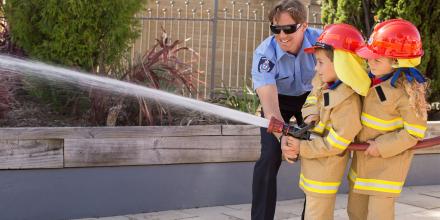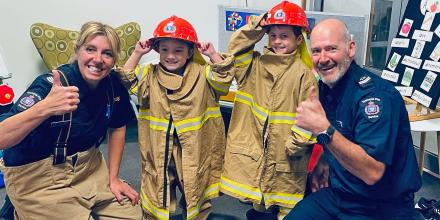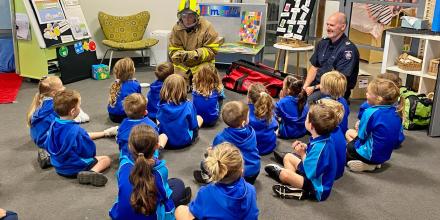The School Fire Education Program is an initiative of the Tasmania Fire Service, as a strategy towards our vision of a Tasmanian community that is safe from the impact of fire.
The program has been designed to teach children from Prep to Grade 6 about basic home fire safety.
The program is offered to all Tasmanian primary schools, and more than 95% of Tasmanian children participate in the program at least twice during their primary school education.
Lessons and resources are delivered in schools by specially trained firefighters of the Tasmania Fire Service.
The program includes:
- Two 30 minute lessons for Prep or Prep/Grade 1 students
- Five 30 minute lessons for students in Grades 1, 2, 3 and 4
- Three 30 minutes lessons for students in Grades 5 and 6
- Fun resources provided to Kindergarten.
The key home fire safety messages are developed over the primary school years so that they are age-appropriate and engaging for students. Home fire safety resources are given out to children in class, and we encourage them to share the home fire safety messages with their family.
Activity books are given out to children in Grades 1 to 4, and can be taken home at the end of the program so that the whole family can participate in the activities to ensure their home is fire safe.
This advice is designed to keep you and your family safe and protect what you value.
Key Home Fire Safety Messages
Prevention
Install a smoke alarm in every bedroom
Smoke alarms warn occupants of a fire and ensure safe evacuations. Every home should have working smoke alarms installed in each sleeping area, hallway and at the top of the stairway if you live in a house with more than one level. They provide an early warning of fire, giving people more time to get out safely and potentially saving thousands of dollars in property damage.
The Tasmania Fire Service recommends smoke alarms that meet the Australian Standard.
Smoke alarms may be powered by:
- 240V mains electricity (hard-wired by an electrician)
- 9V 10 year long-life lithium batteries or
- 9V alkaline batteries (these should be replaced at least every twelve (12) months – a good time is at the end of daylight savings).
Smoke alarms should be tested monthly, cleaned regularly, and the battery replaced if it is not working. Smoke alarms should be replaced at least every ten (10) years.
Two Metres from a heater/fire
Always keep clothes, newspapers, kindling and other flammable material at least 2 metres from a heater.
A match/lighter is a tool for adults
Matches and lighters are extremely dangerous in the hands of a child. Store them up high where children can't reach them or lock them away. Teach children that matches and lighters are tools for adults, they are not toys for children.
Cooking (turn it off before you turn away)
Be alert when cooking, keep children out of harm’s way. Pot handles should be turned inward so they won't be knocked over the edge of the stove.
Action
Stop, drop and rock ‘n’ roll
If your clothes catch fire, don't run! stop where you are, cover your face with your hands to protect your face and lungs, drop to the ground, and roll back and forth to smother the flames.
Crawl low under smoke (Crawl low and go, go, go)
Call out as you crawl out to warn others if you get caught in smoke, the cleanest air will be several centimetres off the floor. Get down on your hands and knees and crawl to the nearest safe exit.
Plan and practise to escape
- Have an escape plan for the household. Plan two ways out of every room, because in a fire one exit may be blocked.
- Choose one safe meeting place outside where everyone will meet, like the letter box
- Enable doors and windows to be easily unlocked.
Deadlocks and windows locks are a safety feature in many homes and can be deadly in a fire. Keys must be readily accessible and the doors and windows must be easily opened in the event of a fire.
If a fire starts:
- Crawl low (under smoke) and go, go, go to the nearest exit
- Call out as you crawl out to warn others
- Everyone meet and stay at your one safe meeting place outside (e.g. letterbox)
- Get out and stay out
- Phone triple zero (000).


Related pages

Pre-school & Child Care
Tasmania Fire Service (TFS) receives regular requests from preschools and child care centres asking...

Prep
Children from Prep learn that Tasmania Fire Service firefighters are your friends.

Kindergarten
Kindergarten students are introduced to firefighters as your friends in their community, and to the...

